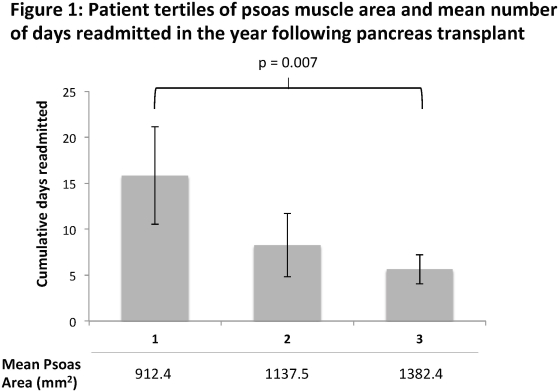Morphometric and Metabolic Correlates of Frailty in Pancreas Transplant Recipients
Surgery, Emory University, Atlanta, GA.
Meeting: 2018 American Transplant Congress
Abstract number: 481
Keywords: Kidney/pancreas transplantation, Morbidity, Pancreas transplantation, Resource utilization
Session Information
Session Name: Concurrent Session: Pancreas and Islet - 2
Session Type: Concurrent Session
Date: Tuesday, June 5, 2018
Session Time: 2:30pm-4:00pm
 Presentation Time: 2:42pm-2:54pm
Presentation Time: 2:42pm-2:54pm
Location: Room 4C-3
Background: Prediction of survival and health resource utilization in the pancreas transplant population requires novel approaches to risk stratification. We studied whether sarcopenia and osteopenia, as correlates of frailty, would predict adverse outcomes, including rehospitalization, graft loss, and death.
Methods: We reviewed records for the last 100 consecutive pancreas transplants, including simultaneous kidney pancreas (SPK) and pancreas after kidney (PAK) operations, at our center. Demographic, comorbidities and diabetic complications were studied for patterns with regard to graft and patient survival and hospital readmissions. Post-transplant DEXA bone demineralization results and psoas muscle area (PMA) relative to body surface area were studied for correlation with clinical outcome by logistic regression.
Results: Among the study sample, 46% were female and 35% were African American. The mean age at transplant was 38.5 +/- 7.3 years. At time of transplant, the mean Karnofsky Performance Score was 76.5 +/- 9.6, 18% of patients had known coronary artery disease, 59% had peripheral arterial disease, 59% had retinopathy, and 6% carried a diagnosis of gastroparesis. 79 patients had DEXA scores within 3 months of transplant, with 67% of those showing osteopenia, and 19% osteoporosis (mean t-score -1.91 +/- 0.92). Patient survival was 98% at one year, but 10% of patients were admitted for >14 days for their transplant admission and 19% spent >14 days inpatient during readmissions over the first transplant year. Sarcopenia on peri-transplant cross-sectional imaging correlated with burden of readmissions but not index length of stay (figure 2).
Conclusions: Among pancreas recipients, sarcopenia predicts resource utilization in the first year after transplant better than comorbidities or standard measures such as performance status. Gastroparesis diagnosis is uncommon preoperatively, but is a frequent reason for readmission post-transplant. Sarcopenia, in conjunction with higher-fidelity clinical assessments of frailty, may be useful in preoperative identification and intervention on high-risk transplant candidates.
CITATION INFORMATION: Parsons R., Wolosyn J., Lynch R. Morphometric and Metabolic Correlates of Frailty in Pancreas Transplant Recipients Am J Transplant. 2017;17 (suppl 3).
To cite this abstract in AMA style:
Parsons R, Wolosyn J, Lynch R. Morphometric and Metabolic Correlates of Frailty in Pancreas Transplant Recipients [abstract]. https://atcmeetingabstracts.com/abstract/morphometric-and-metabolic-correlates-of-frailty-in-pancreas-transplant-recipients/. Accessed December 19, 2025.« Back to 2018 American Transplant Congress

